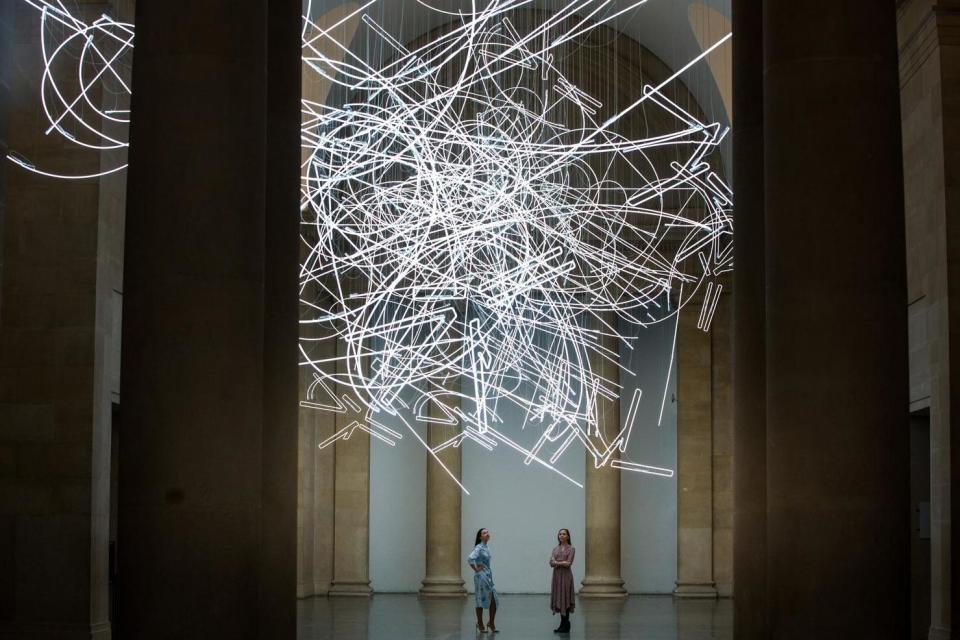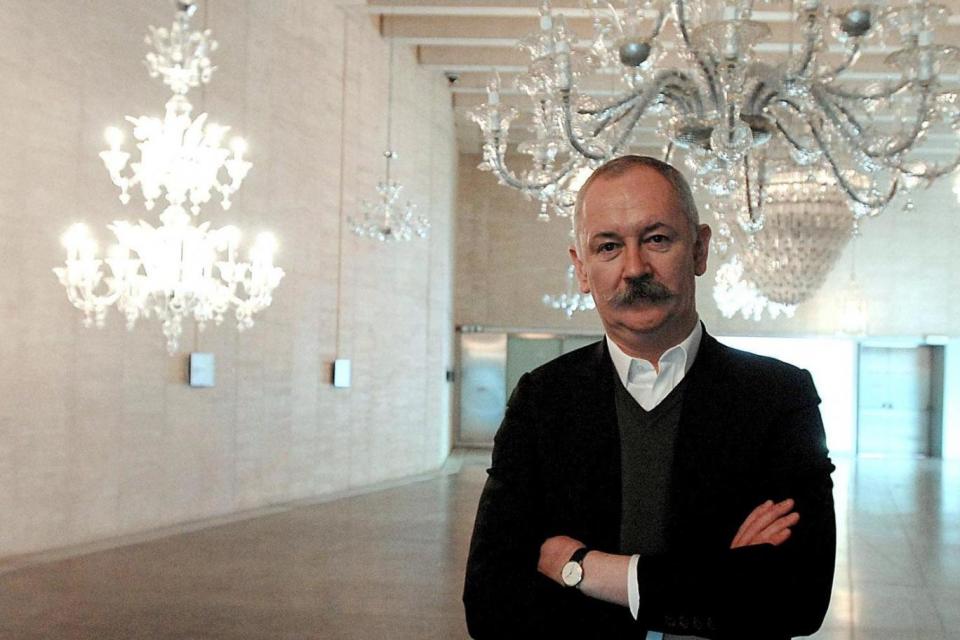Temple of light: Cerith Wyn Evans’s neon installation at Tate Britain

A terrific feat of art and engineering opens at Tate Britain tomorrow. Hanging from the ceiling of the Duveen Galleries, the three neo-classical halls that are the spine of the building, is an extraordinary constellation of neon sculptures: huge lines, loops, arcs and lozenges of white light.
When I visit, the artist Cerith Wyn Evans is watching the progress of this huge and complex work. I meet him in the north Duveen gallery beneath this luminous “drawing in space”. Nearby, technicians are busily attaching neon forms to long electrical cables dangling from the ceiling, each one carefully numbered and marked in a diagram on the floor.
Seen en masse from a distance the neons look tangled, but as you walk below them they separate and form patterns, implying movement. They are based on the notation of steps in Noh, a tightly codified traditional form of dance from Japan. Forms in Space… by Light (in Time), as the work is called, is spectacular; many visitors will quickly reach for their smartphones. But they might find it difficult to capture.
“I’ve tried to do something which is hard to photograph,” Wyn Evans tells me in a musical Welsh accent. “Everything is trafficked through social media and, before you know it, it’ll be around the world. That’s just the nature of producing visual art these days, especially something which is — dare I say it without sounding arrogant — photogenic in the way that this piece is.” But he wanted to make the work so that nothing could match being “in the space of the piece, here and now”.

Wyn Evans, 59, knows the Duveens and Tate Britain better than most. “For my 12th birthday, my dad brought me as a treat from Wales, so we know exactly how long it was since I first walked in here,” he says. “And, precocious as I must have been at the time — it seems mad to think of it now, that a 12-year-old could think it — I really wanted to see the Mark Rothkos.” The Abstract Expressionist’s paintings were “like pop stars for me”, he says.
Art became Wyn Evans’s life, and several years later he moved from his home in Llanelli to study at Central Saint Martins college in Charing Cross Road. He arrived amid a dramatic rupture in the capital’s history, when punk was exploding; the Sex Pistols had played their first, infamous gig at Saint Martins the previous year. “It was the most wonderful place to be, slap-bang in the middle of all of it. At the time, you just felt like the cat who’d got the cream, because at lunchtime you’d go to the pub on the corner and there’d be Sid Vicious getting pissed.”
As the punk scene died and New Romanticism emerged, Wyn Evans became a significant figure in the gay scene around the Blitz club and Taboo, the haunts of a new breed of artists and performers, such as the dancer Michael Clark, pop star Boy George and the artist and film director Derek Jarman. By now a film-maker himself, he helped picture this landmark moment in British queer culture, capturing the subversive performances of Leigh Bowery and working as an assistant on Jarman’s films, while also beginning to find his own voice.
Today, Wyn Evans retains some of the flamboyance that defined New Romanticism — he’s dressed in a beautiful, red-brown Buddhist robe from Tibet with a jade silk scarf. “If I don’t get laughed at by children in the street, I feel as if I’m not dressed properly. And you can get away with murder if someone thinks you’re a holy man.”
One view of his Tate neon installation is as “a kind of shrine — it takes the Duveen Galleries literally. Because it’s temple architecture, actually. So it’s looking at this idea of re-inaugurating its temple-like qualities.” A major influence on Wyn Evans’s thinking was Marcel Duchamp, the father of conceptual art. Three neon sculptures in the central Octagon gallery directly quote forms in Duchamp’s seminal work the Large Glass (1915-23), of which Tate owns a version.
Duchamp took these shapes from opticians’ eye charts and cryptically called them Oculist Witnesses. He was fascinated, like many modern artists, by the idea of a fourth dimension.
Visually quoting Duchamp also has “a political aspect to it”, he explains. “I voted very much Remain… Especially since we are in the epicentre of somewhere that is branding itself as Tate Britain. What does Britain mean? And what are we about to step into? Because Marcel Duchamp left France to move to America, and in a sense there needs to be the free movement of people in relation to the free movement of ideas.”
He is aware of the complexities of these multiple references. He admits that he must have been “a real pain in the arse” to the people at the Tate who are charged with explaining the work to the public. “My tendency is that I’d rather bamboozle people than just undersell them their intelligence,” he says. He was “knocked for six” in one conversation where he was told that what people want is “snackable” content.
“It’s bloody Alan Partridge, it’s beyond the pale, this toe-curlingly embarrassing analogy of food with the idea of information. Like you really are so grotesque that you have to pick in some horribly anorexic way around what you choose to communicate to another person.”
He wants to allow viewers the space to think, to “spend some time where you’re not worrying about whether you’re consuming it or whether you’re really getting it, and rushing over to the label on the wall in order for it to tell you exactly.”
Perhaps a good starting point is to think of the installation as a vast neon star map; the work is called Forms in Space… by Light (in Time), after all. “These footsteps in the sky, this drawing in space, was somehow an attempt to consider that there’s this vast, universal time that is also the backdrop to all of this,” Wyn Evans says. “It does have these aspirations to think really, really big, to think cosmically. I thought, ‘If you are going to be given a really big gig, why hold back?’”
Cerith Wyn Evans’s Forms in Space… by Light (in Time) is at Tate Britain, SW1 (020 7887 8888; tate.org.uk) from tomorrow until August 20.

 Yahoo News
Yahoo News 